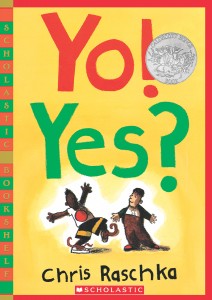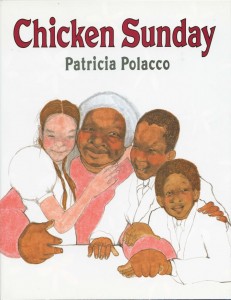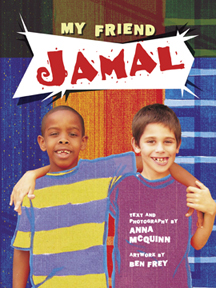2018 School Spending Survey Report
How Cross-Racial Scenes in Picture Books Build Acceptance
A study by author Krista Maywalt Aronson revealed that children who looked at picture books portraying children from different races together reported more interest in playing across difference.
 If asked, most children’s book enthusiasts—writers and illustrators, editors and publishers, librarians and teachers, and parents—would surely agree with poet Lucille Clifton that “the literature of America should reflect the children of America.” Yet in 2014, our children’s books don’t reflect our population. Fewer than 10 percent of books published in 2013 featured children of color, according to statistics gathered by the Cooperative Children’s Books Center. Even more rare are the picture books that depict children making positive connections across racial differences. This absence sends a subtle message to children, as if we were telling them, “It’s okay to only play with children who are like you” or that “children like you don’t play with children who are racially different from you.” How do we know? Research, led by psychologists Lindsey Cameron in England, Cristina Stefanile in Italy, and Krista Aronson (co-author of this article) in the United States, has indicated that the inclusion of these cross-group images encourages cross-group play. In a study investigating how kids respond to cross-racial depictions in picture books, Aronson and her colleagues randomly assigned children to two groups. The first group was read books that depicted children from different races playing together and having fun. The second group was read similar books, but with children from only one racial group.
If asked, most children’s book enthusiasts—writers and illustrators, editors and publishers, librarians and teachers, and parents—would surely agree with poet Lucille Clifton that “the literature of America should reflect the children of America.” Yet in 2014, our children’s books don’t reflect our population. Fewer than 10 percent of books published in 2013 featured children of color, according to statistics gathered by the Cooperative Children’s Books Center. Even more rare are the picture books that depict children making positive connections across racial differences. This absence sends a subtle message to children, as if we were telling them, “It’s okay to only play with children who are like you” or that “children like you don’t play with children who are racially different from you.” How do we know? Research, led by psychologists Lindsey Cameron in England, Cristina Stefanile in Italy, and Krista Aronson (co-author of this article) in the United States, has indicated that the inclusion of these cross-group images encourages cross-group play. In a study investigating how kids respond to cross-racial depictions in picture books, Aronson and her colleagues randomly assigned children to two groups. The first group was read books that depicted children from different races playing together and having fun. The second group was read similar books, but with children from only one racial group.  After six weeks, they found that children in the first group reported greater comfort and interest in playing across difference than children in the second group. Perhaps even more importantly, the first group reported that these positive attitudes remained three months after the study was completed. The fact that reading cross-group books can have such a lasting impact on children’s attitudes is great news. The bad news? In American trade picture books, there are surprisingly few examples of cross-race contact. Aronson and her colleagues created their own such books for the studies. When we searched for picture books depicting positive interactions between two or more children of different races, we found fewer than a dozen titles. This would suggest that most American children have rarely or never seen a cross-race friendship depicted in a picture book. Why do books depicting positive cross-race interaction work? Because when we see someone like us doing something with someone different from us, we become more open to doing it ourselves. Psychologists call this vicarious contact. It can ease children’s anxiety about interacting across difference because they have seen that it’s really fun. It also expands their thinking about the group they belong to. After reading, children think, “People like me play with people who are different from me.” According to Aronson, research suggests an effective cross-group book must
After six weeks, they found that children in the first group reported greater comfort and interest in playing across difference than children in the second group. Perhaps even more importantly, the first group reported that these positive attitudes remained three months after the study was completed. The fact that reading cross-group books can have such a lasting impact on children’s attitudes is great news. The bad news? In American trade picture books, there are surprisingly few examples of cross-race contact. Aronson and her colleagues created their own such books for the studies. When we searched for picture books depicting positive interactions between two or more children of different races, we found fewer than a dozen titles. This would suggest that most American children have rarely or never seen a cross-race friendship depicted in a picture book. Why do books depicting positive cross-race interaction work? Because when we see someone like us doing something with someone different from us, we become more open to doing it ourselves. Psychologists call this vicarious contact. It can ease children’s anxiety about interacting across difference because they have seen that it’s really fun. It also expands their thinking about the group they belong to. After reading, children think, “People like me play with people who are different from me.” According to Aronson, research suggests an effective cross-group book must - Depict children who are recognizably different from each other engaging in normal, everyday activities that readers can relate to;
- Portray the characters doing something positive together and having something in common; and
- Demonstrate that everyone is included as an equal partner in the activities. Stories between adults and children or between children with unequal status, such as during segregation, aren’t as effective in stimulating vicarious contact.
 Aronson and her colleagues found that books in which differences are evident only in the illustrations—for American trade examples, see Lottie Paris and the Best Place by Angela Johnson (S. & S., 2013) and Yo! Yes? by Chris Raschka (Orchard Books, 1993)—can be just as effective as those in which the differences are emphasized in the story itself, such as Chicken Sunday by Patricia Polacco (Philomel, 1992) and My Friend Jamal by Anna McQuinn (Annick, 2008). Finally, Aronson found that exposure to at least six cross-group books is optimal. To maximize the impact of these books, she says, educators should initiate a conversation with students with these key talking points:
Aronson and her colleagues found that books in which differences are evident only in the illustrations—for American trade examples, see Lottie Paris and the Best Place by Angela Johnson (S. & S., 2013) and Yo! Yes? by Chris Raschka (Orchard Books, 1993)—can be just as effective as those in which the differences are emphasized in the story itself, such as Chicken Sunday by Patricia Polacco (Philomel, 1992) and My Friend Jamal by Anna McQuinn (Annick, 2008). Finally, Aronson found that exposure to at least six cross-group books is optimal. To maximize the impact of these books, she says, educators should initiate a conversation with students with these key talking points: - Emphasize that the kids are having fun together.
- Help students recognize what the characters have in common. Are they book lovers or dancers? Dinosaur or space enthusiasts? Basketball players or superheroes?
- Consider pointing out differences among the characters. However, racial and cultural differences, whether or not they are referred to in the text, don’t have to be emphasized in discussion in order for the books to be effective.
- Impress upon children that the characters are connected in a positive way. That "friends" is another group category that they both belong to.
RELATED
RECOMMENDED
CAREERS
The job outlook in 2030: Librarians will be in demand
CAREERS
The job outlook in 2030: Librarians will be in demand
ALREADY A SUBSCRIBER? LOG IN
We are currently offering this content for free. Sign up now to activate your personal profile, where you can save articles for future viewing





Add Comment :-
Comment Policy:
Comment should not be empty !!!
Marcia
Great article. My daughter is interested in talking about different cultures, and I love the celebration of friendship across groups. Recently read JUNA'S JAR by Jane Bahk, which depicts a sweet friendship between a Korean girl and a Latino boy. I think it'll be released in January.Posted : Dec 28, 2014 11:39
Mara
Oops! I followed a link tweeted today and didn't pay attention to how long ago this article had been posted. Sorry!Posted : Dec 11, 2014 06:42
Mara
A few that spring to mind just off the top of my head are EACH KINDNESS by Jackie Woodson, BLOCK PARTY TODAY! by Marilyn Singer, and ONE GREEN APPLE by Eve Bunting, but I know there must be many many more, and not just from one publisher. I'm concerned that some readers may be assuming that if you didn't find many picture books showing interracial friendships among children, that means you did find many picture books showing children interacting only with children of the same race. I'd be surprised if that were true. When I looked at my last five picture books, I realized all of them would be disqualified because they featured diverse groups of friends and neighbors that included both children and adults. When I looked at some of my favorite recent picture books, I saw friendships between a boy and a robot, a girl and a bear, a girl and a squash, and lots and lots and lots of books that don't include humans at all or have nothing to do with friendship. I'm guessing picture books that show children of any race playing together may be a smaller subset than we might expect.Posted : Dec 11, 2014 06:39
Marjorie (MWD)
I am coming to this discussion very late... I am very interested to hear about how difficult it is to find books depicting cross-racial friendships. I have just highlighted your work in a blog post and made a (very) few suggestions of books to add to the bibliography, but I suspect you will reject at least one of them! http://mirrorswindowsdoors.org/wp/picture-books-featuring-cross-racial-friendships/Posted : Sep 09, 2014 10:17
Shoshana
This seems like such a simply concept, and it's surprising (even with the statistics we have on diversity) that so few books fit the bill. I guess it goes along with the idea that books about non-dominant cultures are a niche market - books about each race are just for the members of that race, so why would two kids who look different show up in the same picture book?... I hope we're on our way to fixing this sort of thing.Posted : May 18, 2014 11:56
Anne Sibley O'Brien
Thanks, Sheila, for the request for the list of titles we identified - books that show children of different races sharing activities and having fun together. I just posted the list on my blog, with jackets: http://coloringbetween.blogspot.com/2014/05/cross-group-books.html Please add suggestions of other picture books, on the blog or here.Posted : May 15, 2014 06:55
Sheila Kelly Welch
Hello, Thank you for this informative article. It's great to have research that shows how books can make a positive impact on children's attitudes about people who are different from themselves. I was surprised to see that so few books were found to use for this experiment. It would be helpful for you to offer a list of these books, and for all of us to search for more such published stories. Let's hope editors and publishers will take note and give careful consideration to adding more of these books to their lists. The emphasis on diversity has been focused on books. I think that magazines have been pushing for diversity for quite a while with a good degree of success. When I illustrated a story for LADYBUG and another for SPIDER, I depicted a daycare home with kids of various races and a mixed race family. Anne has suggested in her articles for the SCBWI Bulletin that artists can and should show diversity in our illustrations. I totally agree. And the research cited in this article confirms our position. Thanks, SheilaPosted : May 15, 2014 05:56
Joni
I too would encourage you to explore the titles offered by Barefoot Books, they promote respect in all aspects of diversity. You'll note physical disabilities in illustrations such as a wheelchair bound girl in Animal Boogie, and many titles that will take youand your children into other cultures such as, Little Leap Forward (A boy's life in pre and Communist China), The Girl With A Brave Heart (a story from Tehran), The Wish Fool (fables from the Islamic world), We All Go On Safari (a story set in Tanzania), Barefoot's Books of Buddhist Tales, Indian Tales, Jewish Tales, African Tales and many more.Posted : May 14, 2014 10:19
Laurie Mattaliano
This is a great topic and it confirms what I have always strongly believed to be true. Children are have an intense capability to absorb the completeness of a book far beyond what is written on the page. However, I do challenge this statement: "When we searched for picture books depicting positive interactions between two or more children of different races, we found fewer than a dozen titles. This would suggest that most American children have rarely or never seen a cross-race friendship depicted in a picture book." Independent publisher Barefoot Books (www.readingbarefoot.com) has published over 650 children's picture book titles and nearly all are either multi-racial or multi-cultural in content and/or art. Illustrations that depict and celebrate the population of the world is a foundation of their mission. There are many (though I agree not enough yet) children who are lucky enough to have these books in their homes & schools. Clearly we need to increase that number! The books are there - we need to get them in the hands of the kids (and adults who are reading to them!) - Thanks for bringing up such a great topic!Posted : May 14, 2014 09:52
Liz
I am so happy to have this research proving what I already knew - that kids need to see picture books full of diverse characters - but I am surprised that you found less than a dozen pictures books like this...are you familiar with the children's book publisher Barefoot Books? Just about every picture book they create includes kids of all skin colors, shapes, sizes, physical abilities, etc. - they intentionally push their illustrators to do this, and the books are wonderful!Posted : May 14, 2014 09:17
Natasha Wing
Good points in this article. We picture book writers and illustrators should conscientiously include cross-race interactions among our characters. I was happy to see that the illustrator for my latest picture book, THE NIGHT BEFORE MY BIRTHDAY (Grosset & Dunlap), included kids of different races attending the birthday party. I thought that was a positive message shown through Amy Wummer's art. Bravo, Amy!Posted : May 14, 2014 07:44